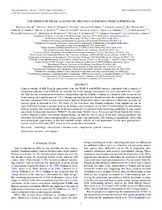| dc.contributor.author | Smith, Mathew | |
| dc.date.accessioned | 2016-05-30T15:04:35Z | |
| dc.date.available | 2016-05-30T15:04:35Z | |
| dc.date.issued | 2013 | |
| dc.identifier.citation | Smith, M. et al (2013). The effect of weak lensing on distance estimates from supernovae. The Astrophysical Journal, 780(1): 1 - 13 | en_US |
| dc.identifier.issn | 0004-637X | |
| dc.identifier.uri | http://hdl.handle.net/10566/2234 | |
| dc.description.abstract | Using a sample of 608 Type Ia supernovae from the SDSS-II and BOSS surveys, combined with a sample of
foreground galaxies from SDSS-II, we estimate the weak lensing convergence for each supernova line of sight.
We find that the correlation between this measurement and the Hubble residuals is consistent with the prediction
from lensing (at a significance of 1.7?). Strong correlations are also found between the residuals and supernova
nuisance parameters after a linear correction is applied. When these other correlations are taken into account, the
lensing signal is detected at 1.4?. We show, for the first time, that distance estimates from supernovae can be
improved when lensing is incorporated, by including a new parameter in the SALT2 methodology for determining
distance moduli. The recovered value of the new parameter is consistent with the lensing prediction. Using cosmic
microwave background data from WMAP7, H0 data from Hubble Space Telescope and Sloan Digital Sky Survey
(SDSS) Baryon acoustic oscillations measurements, we find the best-fit value of the new lensing parameter and
show that the central values and uncertainties on ?m and w are unaffected. The lensing of supernovae, while only
seen at marginal significance in this low-redshift sample, will be of vital importance for the next generation of
surveys, such as DES and LSST, which will be systematics-dominated. | en_US |
| dc.language.iso | en | en_US |
| dc.publisher | American Astronomical Society | en_US |
| dc.rights.uri | AAS grants back to authors the non-exclusive right of republication, subject only to giving appropriate credit to the journal in which the article was published. This non-exclusive right of republication gives authors the right to approve or deny reproduction of all or part of the article and to post the final published version online. | |
| dc.source.uri | http://dx.doi.org/10.1088/0004-637X/780/1/24 | |
| dc.subject | Cosmology | en_US |
| dc.subject | Observation | en_US |
| dc.subject | Distance | en_US |
| dc.subject | Supervanova | en_US |
| dc.subject | Survey | en_US |
| dc.title | The effect of weak lensing on distance estimates from supernovae | en_US |
| dc.type | Article | en_US |
| dc.privacy.showsubmitter | FALSE | |
| dc.status.ispeerreviewed | TRUE | |
| dc.description.accreditation | Web of Science | en_US |

